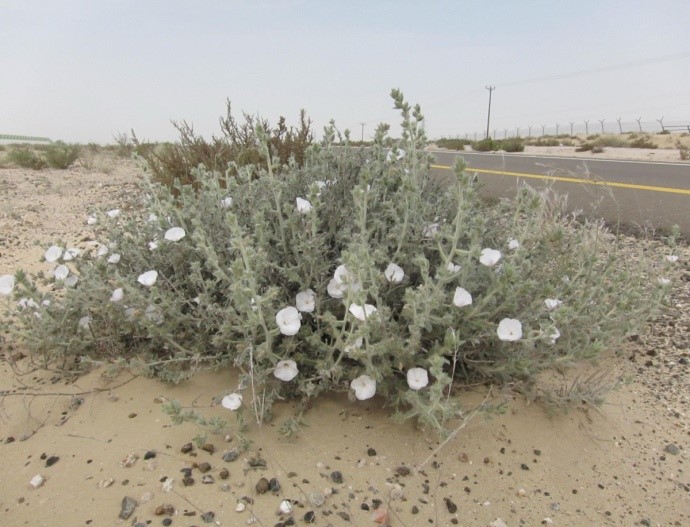
Convolvulus cephalopodus /الرخامى
Convolvulus baluchistanensis Biswas. Convolvulus sericeus Burm.
Al Rukhayma
Bindweed, Morning glory
Al Rukhayma, Rukheemah, Rukhama
Convolvulaceae
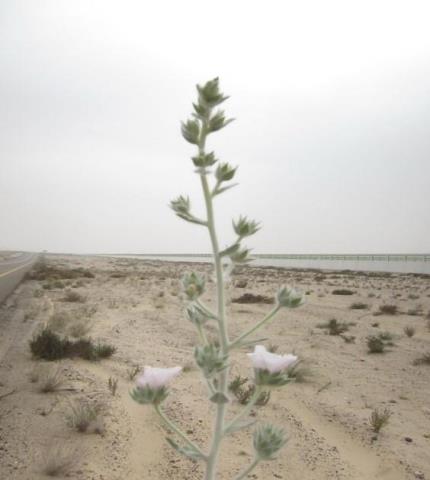
Aerial parts
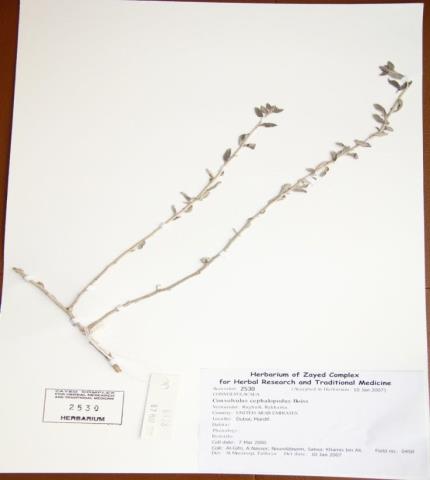
Herbarium specimen
Ethnobotanical Characteristics
Description
Erect or decumbent, herb or undershrub, 14-50 cm tall, with a branched woody base. Branches stout, tomentellous. Leaves are sessile, tomentose, the lower oblanceolate, 15-22 x 4-6 mm, attenuate, obtuse to subacute, the upper broadly elliptic to ovate, 6-10 x 5-8 mm, acute, or slightly mucronate, all leaf margins wavy, veins impressed, prominent on the lower surface, sometimes leaves plicate. Flowers are white-pink, axillary, up to 4 in a cymose head. The peduncle 5-23 mm long, tomentose, hairs mostly patent. Bracteoles are ovate, acute, 8 mm long, with spreading hairs. Sepals are unequal, the outer 8 mm long, ovate-lanceolate, acuminate, inner 7 mm long, linear-lanceolate, acuminate, all sepals are densely tomentose. Corolla 15 mm long. Stamens are unequal. Ovary glabrous but hairy at the top. Style 2.5 mm long, stigma 5 mm long, filiform. Capsule 4 mm long, subglobose, glabrous but apically hairy. Seeds 2.5 mm long, minutely pubescent (Jongbloed et al. 2003, eFloras, Mandaville, 1990).
Habitat and Distribution
Stable sands, perhaps most commonly in coastal areas, but also inland on somewhat silty ground. Tolerant of disturbed ground and sometimes at roadsides (Mandaville, 1990). Very common along Abu Dhabi – Ras Al Khaima littoral on raised sand and low dunes inland of sabkha; also in plantations further east and north, always in sand (A.R. Western, 1989).
Pharmacognosy and Phytochemistry
General appearance
Branches are almost cylindrical in outline, and they vary in colour from brown to yellow and greenish-yellow. The branch is brittle and it breaks easily, exhibiting a hollow area at the central pith zone.
Microscopic characteristics
A surface view of the stem shows an epidermis consisting of polygonal cells that bear oval stomata and many thick, conical, tapering covering trichomes. In the transverse section, the epidermis is shown to consist of rectangular or square cells covered with dark brown cuticle, and also it bears the covering trichomes. It is underlain by fewer layers of small compressed conical parenchyma cells followed by one or two layers of relatively large oblong cells, which surround a layer of oblong cells, many of which contain dark grayish materials, then a few layers of light-yellow compressed parenchyma cells that surround a broad zone of heavily lignified vascular bundles including medullary rays. The xylem vessels are spirally thickened. The pith consists of rounded cells of different sizes.
Powdered plant material
The material consists of the pounded stems and branches. It is a brownish-yellow coarse heterogeneous powder with shredded fragments. It has an odour reminiscent of dried straw and a very bitter taste. Microscopically, the powder shows fragments of the epidermis with conspicuous polygonal cells with their obvious cell walls bearing conical tapering covering trichomes and paracytic oval stomata. There are numerous detached conical covering trichomes of different sizes with their semi-oval bases. Also shown are fragments of greenish grey fibro-vascular bundles with spirally thickened vessels. Isolated fibers are rod-shaped with inconspicuous slit-shaped pits. There are occasional isolated reddish-orange coloring materials.
Parts studied
stem
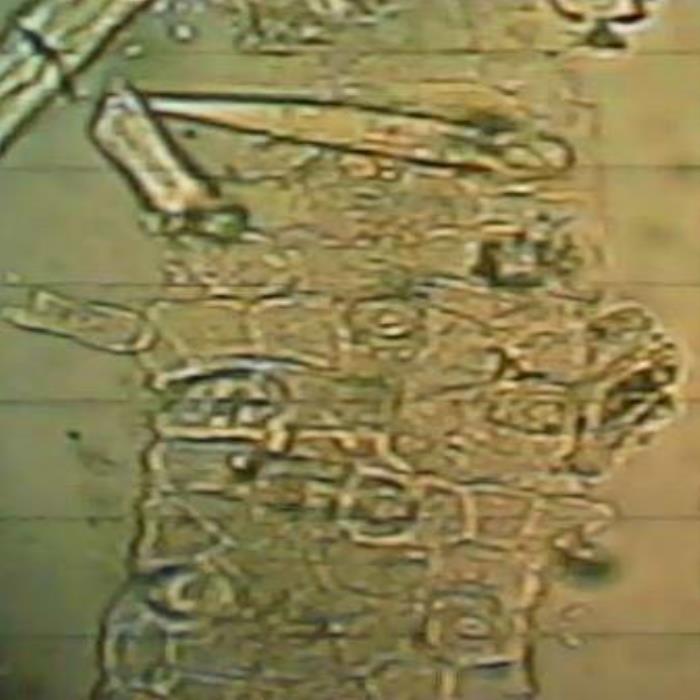
A) Surface view of stem
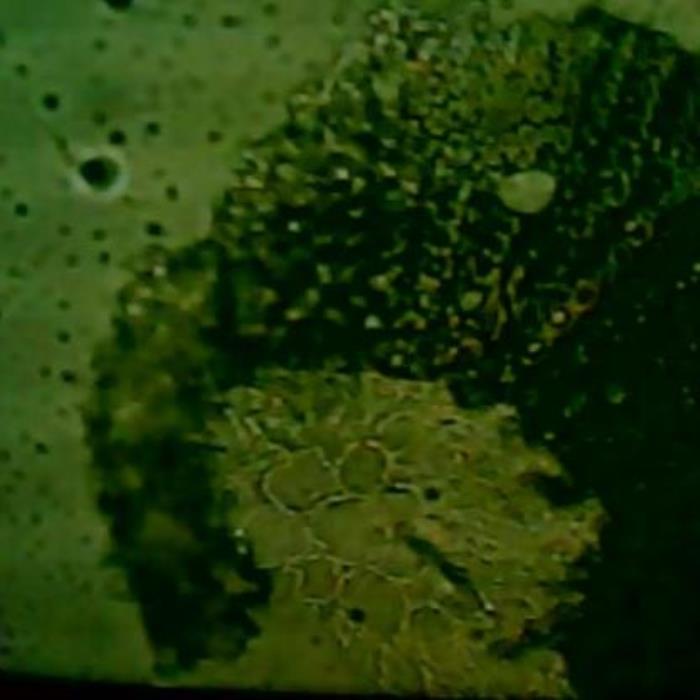
C) Portion of stem
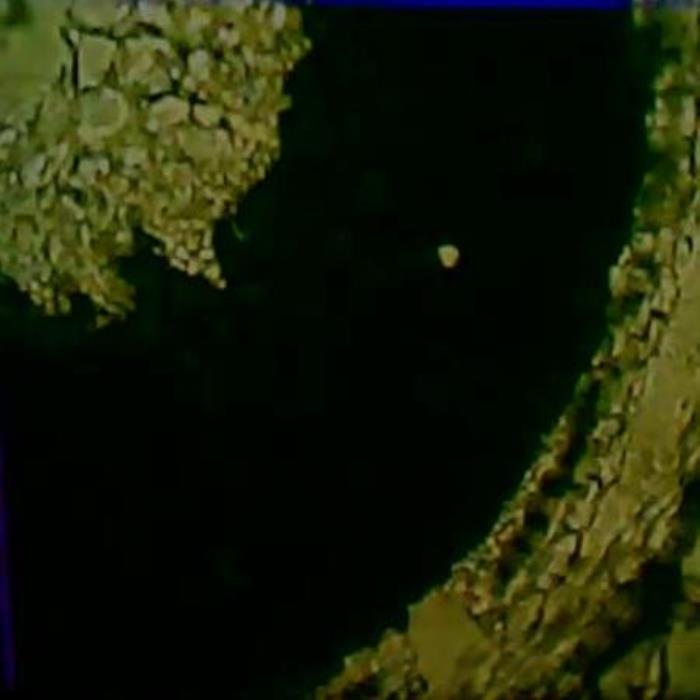
B) TS of stem
- A. Surface view of a portion of the stem showing the epidermis with its polygonal cells and oval stomata together with thick conical tapering covering trichomes.
- B. TS of a representative portion of the stem showing the epidermal layer bearing conical covering trichomes, cortical tissues surrounding a large zone of heavily lignified vascular tissues (dark colored) then the pith that consists of rounded cells of different sizes.
- C. TS of a portion of the stem showing the wide zone of heavily lignified vascular tissues surrounding the clear parenchyma cells of the pith.
Chemical Constituents
Valeraldehyde; propionic acid; uramil-N,N-diacetic acid; propionic acid; N-[2-Hydroxybenzenyl] alanine; 1,2,3-Butanetriol; 1,2,2-Trimethyl cyclopropylamine; N-dl-Alanyl glycine ; Propanenitrile,3-amino-2,3-di(hydroxyl amino)
The following chemical studies were carried out on the plant Convolvulus cephalopodus (Quality Control methods, 1998; Evans, 1996; ZCHRTM unpublished work):
Physicochemical constants
Loss of weight on drying at 105°C: 8.30
Absolute alcohol solubility: 3.20
Water solubility: 15.40
Successive extractives (%)
Petroleum ether (60-80)°C : 1.10
Chloroform : 1.30
Absolute alcohol : 6.00
Ash values (%)
Total ash : 6.00
Water soluble ash : 1.13
Acid insoluble ash (10% HCl) : 0.84
pH values (aqueous solution)
pH of 1% solution : 5.815-5.823
pH of 10% solution : 5.473-5.479
Elemental analyses
Ash values (British Herbal Pharmacopeia)
Assay and identification of element (AOAC International)
|
Apparatus |
AA-6800 Shimadzu-Flame method |
||||
|
Element |
Std. conc. µg/ml(ppm) |
Sample conc.mg/ml |
Samples absorbance |
Actual conc. mg/ml |
Actual conc.(%) |
|
Cr |
1, 2, 4 |
20.028 |
0.0024 |
0.0156700 |
0.00156700 |
|
Zn |
0.5, 1, 2 |
20.028 |
0.0831 |
0.0213450 |
0.00213450 |
|
Cu |
0.5, 1, 2 |
20.028 |
0.0349 |
0.01665 |
0.001665 |
|
Fe |
1, 2, 4 |
20.028 |
0.4339 |
0.83177 |
0.083177 |
|
K |
1, 2, 4 |
20.028 |
1.6283 |
0.92141 |
0.092141 |
|
Pb |
1, 2, 4 |
20.028 |
0.0000 |
0.0000 |
0.0000 |
|
Cd |
0.25, 0.5, 1 |
20.028 |
0.0000 |
0.0000 |
0.0000 |
UV Spectral studies
| Ultraviolet Spectrum (USP reference) | ||||
|
Apparatus |
Milton Roy Spectronic Genesys 5 Spectrophotometer - Milton Roy. |
|||
|
Sample conc. (mg / ml) |
Solvent |
λ max (nm) |
λ min (nm) |
Abs.( λ max - λ min) |
|
0.472 |
Intestinal Fluid simulated without pancreatic pH=7.50.1 |
280 |
259 |
0.612 - 0.524 |
|
1.000 |
Gastric Fluid simulated without pepsin pH =1.20.1 |
no shift |
no shift |
- |
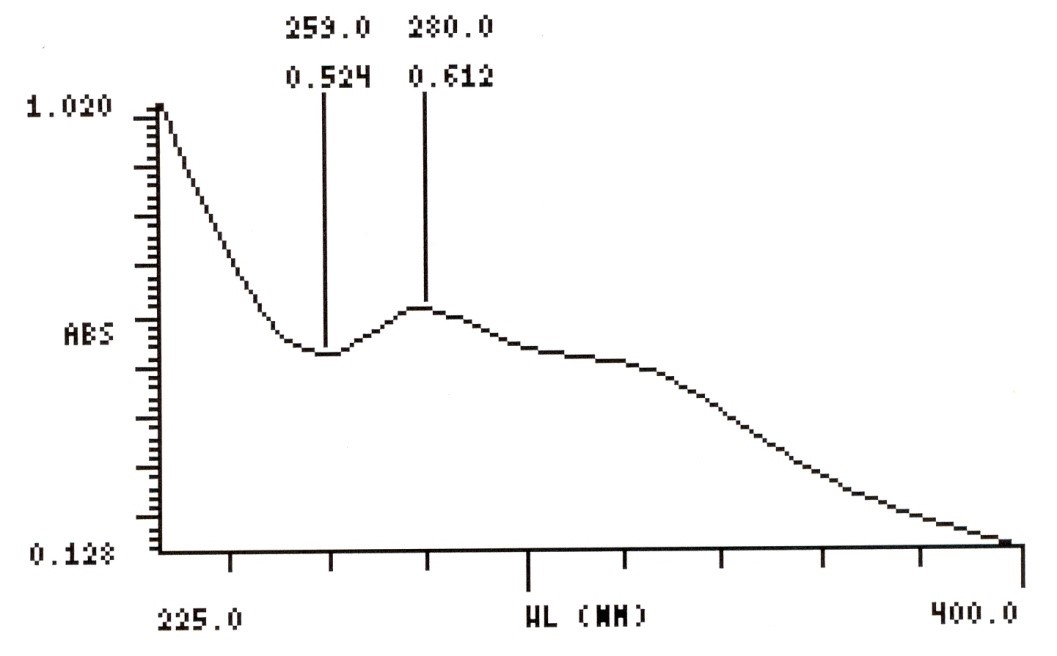
Intestinal Fluid simulated without pancreatic
Chromatographic Studies
Thin layer chromatography (Wagner and Bladt, 1996)

A

B

C

D
TLC fingerprint of Petroleum ether 60-80°C (track 1) and Methanol extract (track 2)
|
Mobile phase Fig. |
A |
: |
Ethyl acetate, methanol, water (100:13.5:10) |
|
|
B&C |
: |
Toluene, ethyl formate, formic acid (5:4:1) |
|
|
D |
: |
Toluene, ethyl acetate (93:7) |
|
Detection |
A |
: |
UV 254nm |
|
|
B |
: |
UV 366nm |
|
Derivatization |
C&D |
: |
Vanillin-Sulphuric acid-vis |
Pharmacological and toxicological studies
Convolvulus is a genus of about 250 species of flowering plants in the bindweed family Convolvulaceae, with a cosmopolitan distribution. Common names include bindweed and morning glory, both names shared with other closely related genera.
The important pharmacological and toxicological activities of the plant Convolvulus cephalopodus reported in various scientific journals are presented in the following brief review:
Oral administration of methanolic extract from Conyza dioscoridis (CD) or Alhagi maurorum (AM) at 200 mg/kg dose exhibits a significant antidiarrheal effect against castor oil-induced diarrhea, while Menthami crophylla (MM), Convolvulus arvensis (CA), Conyza linifolia (CL) produced no significant effect at a dose of 400 mg/kg (Atta, 2004).
The present study evaluated the potential antiulcerogenic effect of juice of whole fresh plant of C. pluricaulis (CPJ) against various experimental gastric ulcer models induced by ethanol, aspirin, 2 hr cold restraint stress and 4 hr pyloric ligation in rats. The antiulcerogenic effect of CPJ was found to be due to augmentation of mucosal defensive factors like Mucin secretion, lifespan of mucosal cells and glycoproteins rather than on the offensive factors like acid-pepsin (Sairam, 2001).
In an investigation, the role convolvulus pluricaulis root extract in the regulation of hyperthyroidism in female mice was evaluated. The possible site of action in the regulation of hyperthyroidism by the plant extract was evaluated. It appeared that the action of the plant extract on thyroid function is primarily mediated through the inhibition of 5'-DI enzyme activity (Panda S, 2001).
The effects of feeding high and low doses of field bindweed Convolvulus arvensis to mice were investigated. Bindweed contains several alkaloids, including pseudotropine, and lesser amounts of tropine, tropinone, and meso-cuscohygrine. Mice fed bindweed exclusively had severe hepatic necrosis and gastritis with ulceration or erosions. Mice fed low doses of bindweed along with standard laboratory mouse diet for 6 or 8 w had no clinical disease or gross lesions on necropsy examination but did have histologic lesions of mild multifocal hepatitis and gastritis (Schultheiss ,1995).
These findings explicitly suggest that the whole plant extract of C. microphyllus possesses a potential CNS-depressant activity (Subhangi, 2001).
The ratio of 3H: 14C of liver cholesterol was significantly higher in rats fed the vegetable diet. Brain cholesterol was found consistently high 3H: 14C ratios, which were not affected by dietary intake. It appears that brain cholesterol level is maintained mainly by synthesis in situ and not by uptake from dietary or other sources (Chen, 1984).
The results on the pharmacological and Toxicological studies carried on Aqueous extract of the Convolvulus cephalopodus (Derelanko 2002; Han, 2003) have been given in the following table in brief:
|
ACTIVITY |
RESULTS |
|||
|
Strong |
Moderate |
Mild |
Negative |
|
|
Analgesic |
|
√ |
|
|
|
Anti-inflammatory |
|
|
√ |
|
|
Anticonvulsant activity |
|
|
√ |
|
|
Antidiarrheal activity |
|
√ |
|
|
|
Effect on rabbit jejunum |
|
|
√ |
|
|
Effect on rat fundus |
√ |
|
|
|
|
Effect on Guinea pig ileum |
√ |
|
|
|
|
Effect on right rat atria |
√ |
|
|
|
|
Studies on biochemical parameters |
|
|
|
√ |
|
Locomotor activity test ↓ |
√ |
|
|
|
|
Motor co-ordination (grip strength & motor activity) ↓ |
√ |
|
|
|
|
Rectal temperature |
|
|
|
√ |
|
Body weight |
|
|
|
√ |
|
Mortality |
|
|
|
√ |
Conclusion
The test substance is safe at the dose tested. The LD50 of the drug was found to be > 2 g/kg (route- gastric intubation). Antispasmodic activity of the plant might help in reducing the propulsive action of the gut function; digestive and carminative effects. These findings are of interest in regard to the medical uses of plant extract as herbal drug for spasmodic effect. Presence of relaxation/ antispasmodic activity showed antidiarrheal/ anti-secretory activity (ZCHRTM unpublished results).

Effect on rat fundus
The single oral dose of the test substance did not produce any adverse effect in the general behavior of the mice. The drug did not show any sign of salivation, nasal discharge, diarrhea or constipation, loss of righting reflex, lacrimation or tremors.
Antimicrobial activity
The aqueous extract of the whole plant did not inhibit the growth of Mycobacterium smegmatis, Candida tropicalis, different strains of Methicillin Resistant Staphylococcus aureus, different strains of ESBL-producing K. pneumonia, E. coli, Pseudomonas aeruginosa.
References
- Atta AH, Mouneir SM.Antidiarrhoeal activity of some Egyptian medicinal plant extracts. J. Ethnopharmacol. Jun 2004; 92: 303-9.
- Chen ML, Chia DF, Run JQ. Effect of dietary vegetable (water convolvulus) on cholesterol metabolism in rats. J Nutr. Mar; 1984, 114:503-10.
- Jonbloed, M. V., Feulner, G. R., Boer, B. & Western, A. R. (2003). The comprehensive Guide to the Wild Flowers of the United Arab Emirates, Erwda, Abu Dhabi, U.A.E.
- Mandaville, J. P. (1990). Flora of Eastern Saudi Arabia. Kegan Paul International, Riyadh, Saudi Arabia.
- Panda S, Kar A. Inhibition of T3 production in levothyroxine-treated female mice by the root extract of Convolvulus pluricaulis. Horm Metab Res. Jan 2001; 33:16-8.
- Sairam K, Rao CV, Goel RK.Effect of Convolvulus pluricaulis Chois on gastric ulceration and secretion in rats. Indian J Exp Biol. Apr 2001;39:350-4.
- Schultheiss PC, Knight AP, Traub-Dargatz JL, Todd FG, Stermitz FR. Toxicity of field bindweed (Convolvulus arvensis) to mice. Vet Hum Toxicol. Oct 1995; 37:452-4.
- Subhangi A. Pawar 1 , J.N. Dhuley 1 and S.R. Naik 2Neuropharmacology of an Extract derived from Convolvulus microphyllus Pharmaceutical Biology, Vol.39, No.4, 2001, 39: 253-258
- Western, A. R. (1989). The Flora of United Arab Emirates. An introduction. Publications of the U.A.E. University.
